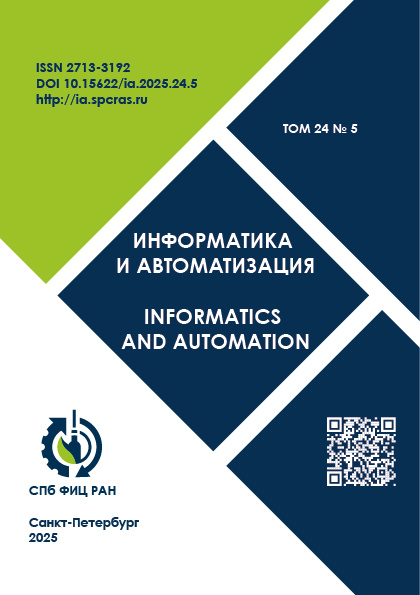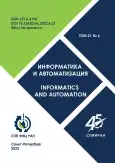Том 21, № 6 (2022)
Статьи
СПБ ФИЦ РАН — 45 ЛЕТ НАУЧНОЙ ДЕЯТЕЛЬНОСТИ
Аннотация
 1085-1096
1085-1096


Искусственный интеллект, инженерия данных и знаний
Анализ информационного и математического обеспечения для распознавания аффективных состояний человека
Аннотация
 1097-1144
1097-1144


Рекуррентные нейронные сети с непрерывным обучением в задачах многофункциональной обработки новостных потоков
Аннотация
 1145-1168
1145-1168


Методы и модели извлечения знаний из медицинских документов
Аннотация
 1169-1210
1169-1210


Алгоритмы и измерительный комплекс классификации источников сейсмических сигналов, определения расстояния и азимута до пункта возбуждения поверхностных волн
Аннотация
 1211-1239
1211-1239


Цифровые информационно-коммуникационные технологии
Сравнительное исследование моделированием протоколов маршрутизации OSPF и EIGRP
Аннотация
Компьютерные сети основаны на технологии, обеспечивающей техническую инфраструктуру, в которой протоколы маршрутизации используются для передачи пакетов через Интернет. Протоколы маршрутизации определяют, как маршрутизаторы взаимодействуют друг с другом путем распространения информации. Они используются для описания того, как маршрутизаторы взаимодействуют друг с другом, изучения доступных маршрутов, построения таблиц маршрутизации, принятия решений о маршрутизации и обмена информацией между соседями. Основная цель протоколов маршрутизации — определить наилучший маршрут от источника к месту назначения. Частный случай протокола маршрутизации, работающего в автономной системе, называется протоколом внутренней маршрутизации (IGP — Internal Gateway Protocol). В статье анализируется проблема правильного выбора протокола маршрутизации. Open Shortest Path First (OSPF) и Enhanced Internal Gateway Routing Protocol (EIGRP) считаются ведущими протоколами маршрутизации для приложений реального времени. Для этого их выбирают для изучения. Основной целью исследования является сравнение предложенных протоколов маршрутизации и их оценка на основе различных показателей производительности. Эта оценка осуществляется теоретически – путем анализа их характеристик и действия, и практически – посредством имитационных экспериментов. После изучения литературы определяются сценарии моделирования и количественные показатели, по которым сравнивается производительность протоколов. Во-первых, сетевая модель с OSPF разрабатывается и моделируется с помощью симулятора OPNET Modeler. Во-вторых, EIGRP реализован в том же сетевом сценарии, и выполняется новое моделирование. Реализация сценариев должна собрать необходимые результаты и проанализировать работу двух протоколов. Данные должны быть получены, а оценка и вывод должны быть сделаны в отношении определенных количественных показателей.
 1240-1264
1240-1264


Микросервисная архитектура виртуальных тренажерных комплексов
Аннотация
 1265-1289
1265-1289


Информационная безопасность
Генерация данных для моделирования атак на БПЛА с целью тестирования систем обнаружения вторжений
Аннотация
 1290-1327
1290-1327


Методика обнаружения аномалий и кибератак на основе интеграции методов фрактального анализа и машинного обучения
Аннотация
 1328-1358
1328-1358


Робототехника, автоматизация и системы управления
О теоретических основах аэролимнологии: изучение пресных водоемов и прибрежных территорий с применением воздушных робототехнических средств
Аннотация
 1359-1393
1359-1393












